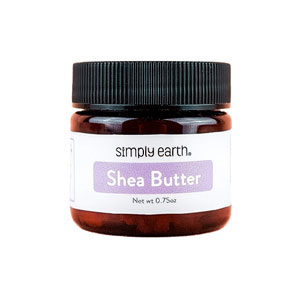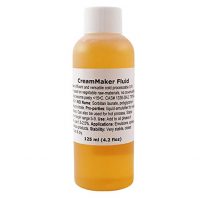This Himalayan salt scrub is gently exfoliating yet incredibly nourishing for dry skin. Instead of indulging in that expensive salt glow spa treatment, get softer, smoother, more glowing skin at home with this natural pink salt scrub recipe.

If you’re looking for a simple pink salt scrub recipe made with natural, easily accessible ingredients, then you’ve landed on the right page.
The basic recipe for this Himalayan salt scrub is only 3 ingredients. But there’s also a recipe with an emulsifier if you’d like to make an emulsifying salt scrub with extra moisturizing properties.
I’ve also included a unique selection of essential oil blends so that you can tailor the scrub to your needs. Options include a calming pink salt scrub for relaxation, a body scrub to ease muscle aches, and a pink salt foot scrub to smooth callused feet, to name just a few.
Finally, I’ll also cover the benefits of using a homemade salt scrub made with Himalayan salt, and why I incorporated this recipe into my self-care routine. But if you’d prefer to skip ahead, you can use the jump to recipe button.
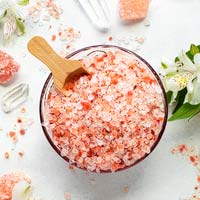
Pink Himalayan salts for skincare
You may have used Himalayan salt in a bath, and we’ve shared many recipes with pink salt, including our Himalayan salt bath, green tea bath, and our milk and honey bath soak, to name just a few.
But in my experience, Himalayan salt has a lot of benefits when used in a homemade body scrub to naturally exfoliate your skin, as well.
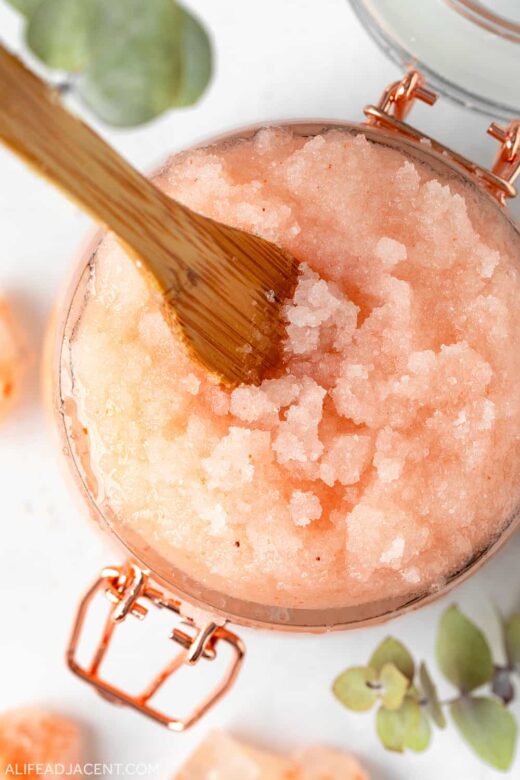
Pink Himalayan salt is a natural rock salt most often mined from the Khewra Salt Mine in Pakistan, which is located approximately 186 miles away from the Himalayas1.
Since pink salt is minimally processed and mined from deep within the earth, it’s said to be protected from environmental contaminants2. It’s also naturally rich in a variety of trace minerals, including magnesium, calcium, chloride, potassium and zinc3, which gives pink salt its sunset pink, light reddish, or pale orange hue.
When it comes to homemade skincare, pink salts’ purity, natural mineral content, and skin-buffing properties are just some of the reasons Himalayan salts are ideal for use in body scrubs.
Himalayan Salt Scrub Benefits
Why use a homemade salt scrub? There’s a reason why salt glow treatments at your local spa are popular, and why every bath and body store has a salt scrub in their line.
But there are more advantages to a Himalayan salt scrub than just exfoliation, so I hope the following benefits inspire you to make this pink salt body polish.
Glowing skin
Gentle exfoliation really does makes your skin glow. Massaging your skin with a Himalayan salt scrub can boost circulation and blood flow, which will give skin that healthy glow.
Regular exfoliation also speeds up the process of skin regeneration, giving an extra boost to new skin cell turnover. It helps remove the build up of dead skin cells, which in turn improves the skin’s radiance4.
Well-being and self-care
A homemade Himalayan body scrub is a wonderful way to pamper yourself and take care of your skin.
From personal experience, I know that a regular self-care routine promotes an overall feeling of well-being. It may even boost your confidence, because taking care of your mind and body can help you look and feel better.
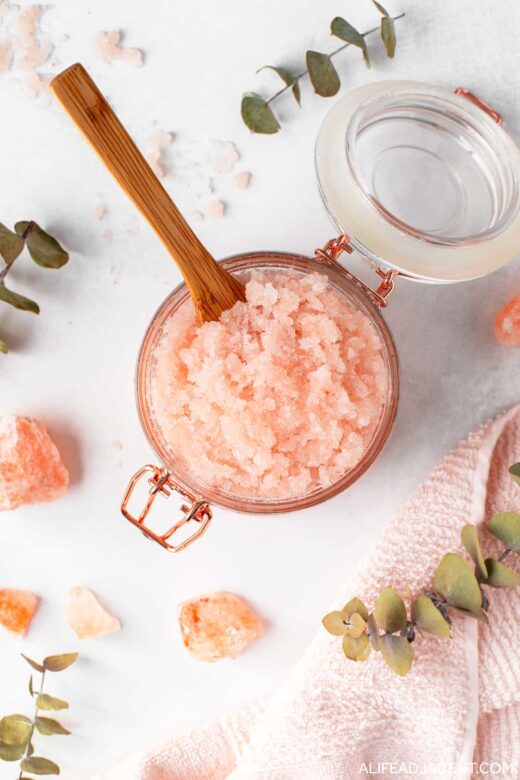
Preventing ingrown hairs
Gently buffing the skin with a homemade Himalayan salt scrub can prevent ingrown hairs by sloughing off the dead skin that can clog hair follicles.
Soothing tired, achy legs
A gentle massage with a salt scrub can help relieve tension, minor muscle aches, and improve lymphatic flow, especially if you add an essential oil blend for sore muscles to your scrub.
Preventing acne
Not only is salt both antibacterial and antiseptic5 (including against acne-causing bacteria6), but a gentle pink salt scrub also cleans your skin and pores thoroughly1, which can prevent further breakouts.
Restful sleep
Massaging your skin before bedtime induces feelings of relaxation, which may help you fall asleep faster. Plus, adding essential oils that help promote sleep to your scrub, such as Bulgarian lavender, can further boost this effect.
Cleansing and deodorizing
Salt is a natural deodorizer, so you might find a Himalayan pink salt scrub beneficial for extra cleansing and detoxifying1, as well as combatting body odor post-workout.
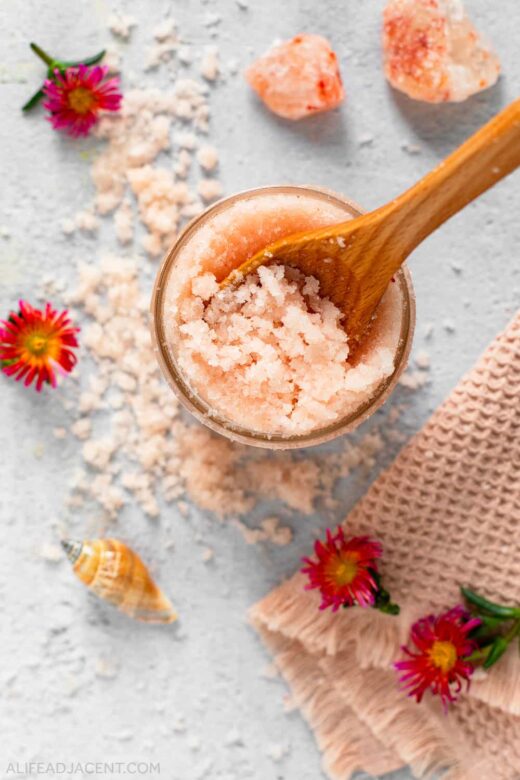
Better absorption of skincare products
Body care products such as lotion or body butter absorb more easily after exfoliation, so buffing your skin with pink salt to remove dead skin cells, can help your skincare products be even more effective.
Energy cleansing
You may have used sage smudging or an aura spray for cleansing, but many cultures use salt in energy clearing practices as well.
When used with intention, salt is believed to absorb negative energy and provide spiritual protection7. Bathing in salt is one way to use salt for this purpose, and using pink salt in a scrub may have similar energy cleansing benefits.
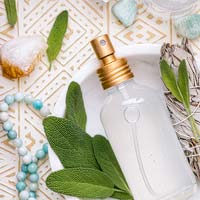
Economical and zero waste bath routine
Finally, a Himalayan salt scrub is affordable to make since it contains common ingredients which you may already have on hand in your own kitchen.
It’s also easy to customize your body scrub with organic ingredients for a more natural, sustainable bath routine. That way, you can skip the toxic, artificially fragranced store-bought body scrubs, and reuse your scrub packaging again and again.
Plus, if you buy your salt scrub ingredients in bulk, you can save even more money over the long term.
Pink Salt Scrub Ingredients
For these Himalayan pink salt scrub recipes, I used extra fine grain Himalayan salts, nourishing MCT oil, and essential oils specifically chosen to add aromatherapeutic benefits.
There’s no point in washing expensive skincare ingredients down the drain, so for a DIY Himalayan salt scrub, you’ll want to keep it simple.
However, I did include an option for an emulsified salt scrub. That recipe contains a natural emulsifier with a silky texture that adds even more moisturizing benefits to your scrub.
Both recipes are free of water, so either way, a preservative is not required.
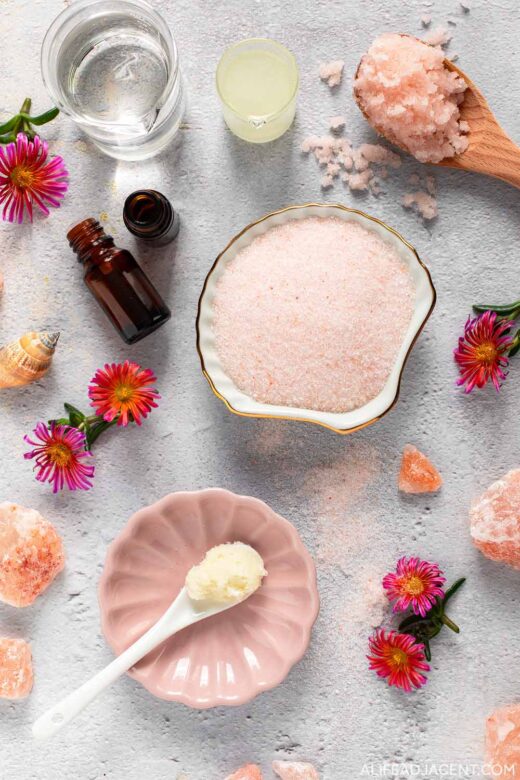
Pink Himalayan salts
By now it’s clear that pink salts are this exfoliating scrub’s main ingredient. Be sure to choose a finely ground, high quality Himalayan salt brand free of additives, fragrances or added colors.
If you already have pink Himalayan salt on hand, but in a coarser grind, that’s okay! Use a food processor or coffee grinder to finely grind your salt before making your scrub, as coarse salt crystals are more likely to irritate your skin.
Carrier oil
MCT oil provides a moisturizing base for this salt scrub, and there are a few reasons why it’s one of the best carrier oils for body scrub.
For one, MCT oil is non-comedogenic and well tolerated by many skin types8. Though it’s derived from coconut oil, MCT oil’s processing removes the pore-clogging fractions, leaving only non-comedogenic caprylic and capric fatty acids behind.
These fatty acids are also completely saturated, making them very stable and resistant to spoilage. So your salt scrub will last a long time without oxidizing, which is important since oxidized (spoiled) oils are linked to skin inflammation and acne9.

In general, the best oil for a Himalayan salt scrub recipe is a low-PUFA carrier oil for the reasons mentioned above. If you don’t have MCT oil, you can also use fractionated coconut oil, which is similar in composition. The next best option would be jojoba oil.
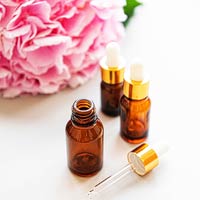
Shea butter
Homemade salt scrubs can be prone to separation, and they may become too liquidy if the oil separates from the salt.
But adding a small amount of shea butter rectifies this issue. It helps hold the scrub together, giving it a firmer texture that’s easily scooped from the jar.
However, shea butter is optional, and you can still make an easy salt scrub using pink salt and a carrier oil.
Natural emulsifier
If desired, you can also add a natural emulsifier to your salt scrub recipe. Since they all have slightly different properties, you’ll end up with a different skin feel depending on which one you use.
Emulsifiers for salt scrub include:
- Glyceryl oleate. Highly viscous and known for its re-fatting (moisturizing) properties, glyceryl oleate adds extra fatty acids and moisturizing benefits to a salt scrub recipe. It leaves a light residue on the skin, so your homemade scrub becomes an in-shower body moisturizer as well as a body polish.
- CreamMaker FLUID. This natural polysorbate alternative helps your scrub rinse off clean, so it’s ideal if you prefer less residual oil on your skin after a scrub.
- Polyglyceryl oleate or sorbitan oleate. These natural oil-based emulsifiers are very similar and can be used interchangeably. They are gently cleansing yet moisturizing, so they leave your skin even more silky and moisturized after exfoliating.
Again, these ingredients are optional and may not be accessible to everyone, but you can add one to make an extra moisturizing scrub for dry skin, or an emulsified scrub that rinses off more easily.
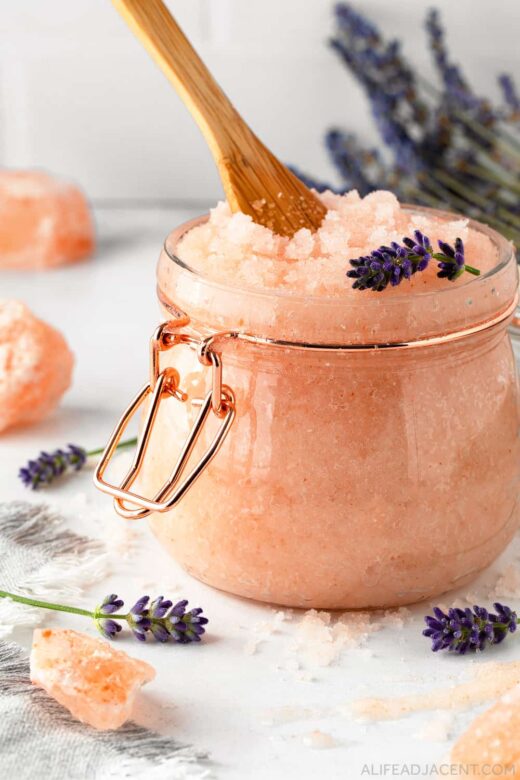
Himalayan Salt Scrub Recipe
1 cup fine pink Himalayan salt
1/4 cup fractionated coconut oil or MCT oil
1 tbsp shea butter, melted
1/2 tbsp natural emulsifier (optional, see options above)
50 drops essential oils (see blends section)
Supplies
Large glass or ceramic mixing bowl
Measuring cups and spoons
Wooden spoon for mixing
Storage container, such as a wide mouth mason jar or clamp lid jar
How to make Himalayan salt scrub
- Combine salt + oil. Measure the Himalayan pink salts into the mixing bowl and pour the MCT oil (or carrier oil of choice) over the salts. Stir the mixture with a wooden spoon until evenly coated.

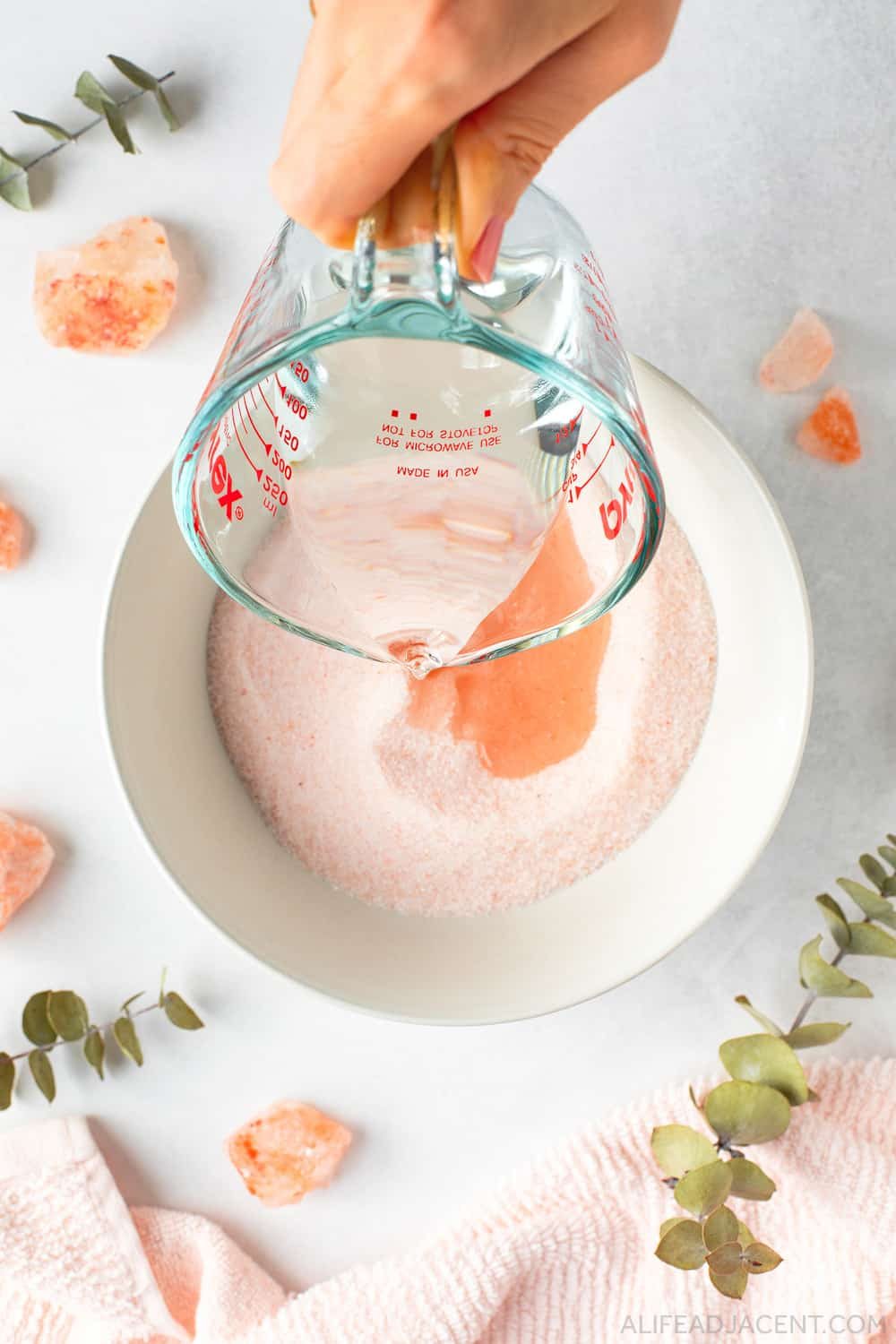
- Melt shea butter. Using the microwave (or a butter warmer on the stovetop), melt the shea butter. Do not overheat, as this small amount of shea butter will liquefy quickly.
- Add shea butter + emulsifier. Pour the melted shea butter over the salt scrub mixture. If adding a natural emulsifier, add it during this step as well. Mix well to ensure everything is evenly incorporated.
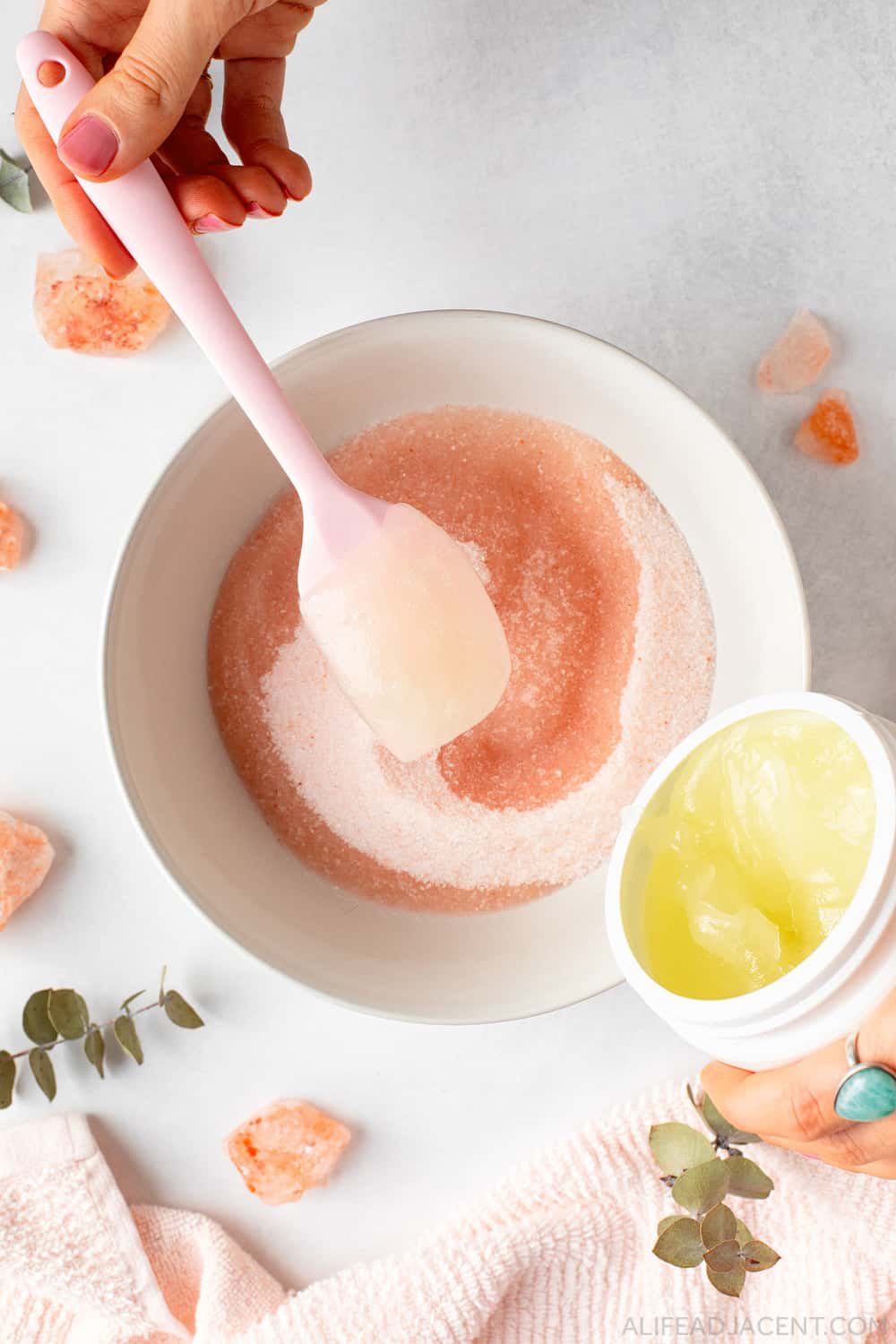
- Add essential oils. Add your favorite essential oil blend and stir the mixture again until evenly combined.
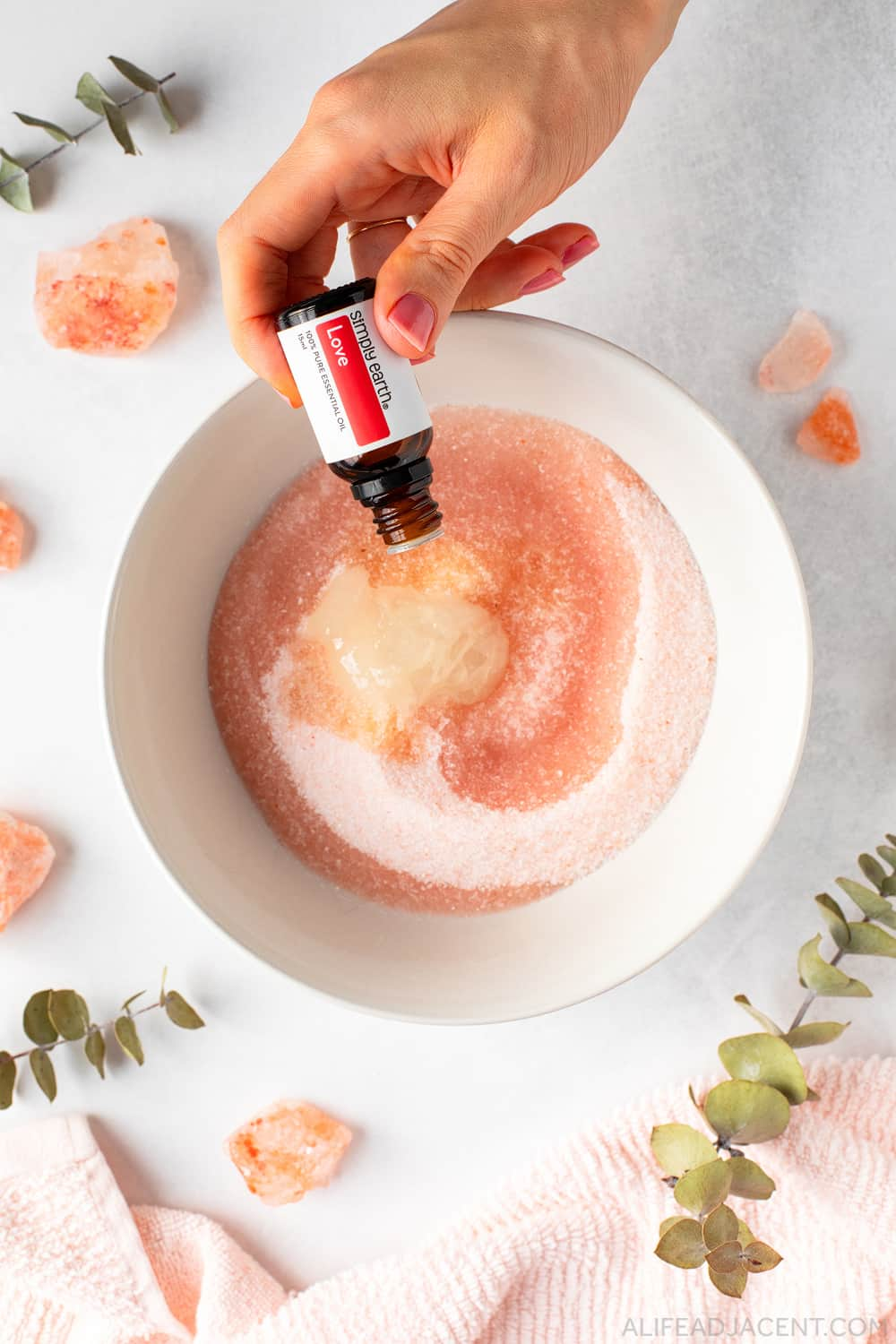

- Package scrub. Transfer the Himalayan salt scrub to an airtight storage container for use, such as a wide mouth mason jar. See container suggestions in the section on packaging salt scrubs below.
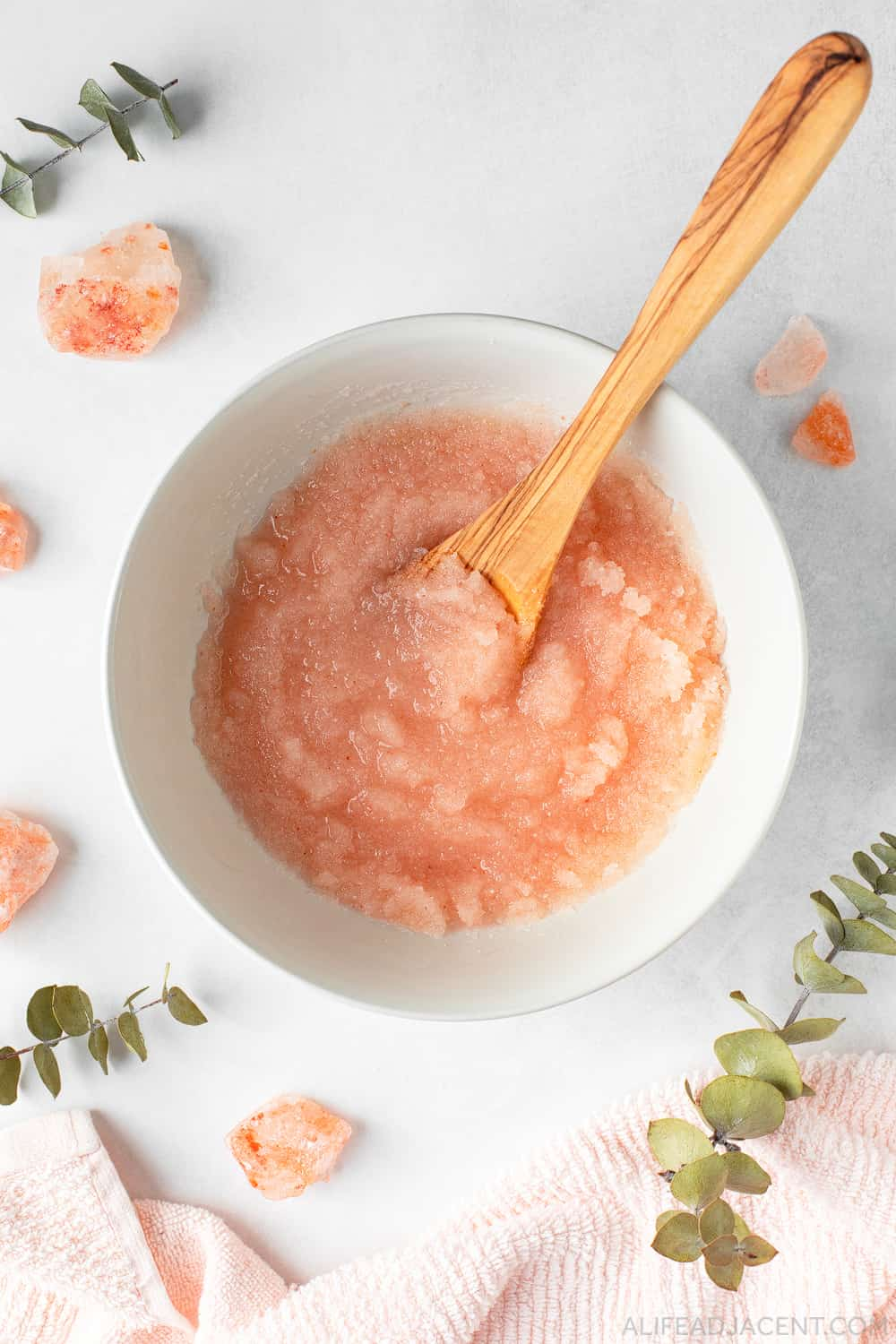
How to use a DIY Himalayan Salt Scrub
Apply pink salt scrub to clean, damp skin as the last step of your shower routine. That way, the carrier oils can lock moisture into your skin.
To use, scoop out a generous handful of scrub from the jar with a clean spoon (not wet hands). Massage the scrub into your skin lightly in a circular motion, focusing on areas that are rough or extra dry, such as elbows or knees.
Alternatively, you can also have your scrub ready to go in a separate container. The key is to not allow any water to get into the scrub jar, or it may grow mold and bacteria.
After you scrub, rinse off the salt with a cool rinse. Pat skin dry with a towel and apply a hydrating lotion or body butter for glowing skin.
Safety tip: oil-based body scrubs can make surfaces slippery, so you may want to sit on the edge of your tub or on a shower stool as your scrub. Please take caution when exiting the bath or shower.
Essential oil blends for Himalayan scrub
Making a Himalayan body scrub with essential oils is optional, so if you have allergy-prone or sensitive skin, you may want to omit them and make an unscented salt scrub recipe instead.
But for aromatherapy benefits, you can pick one of the essential oil blends below that suits your particular needs.
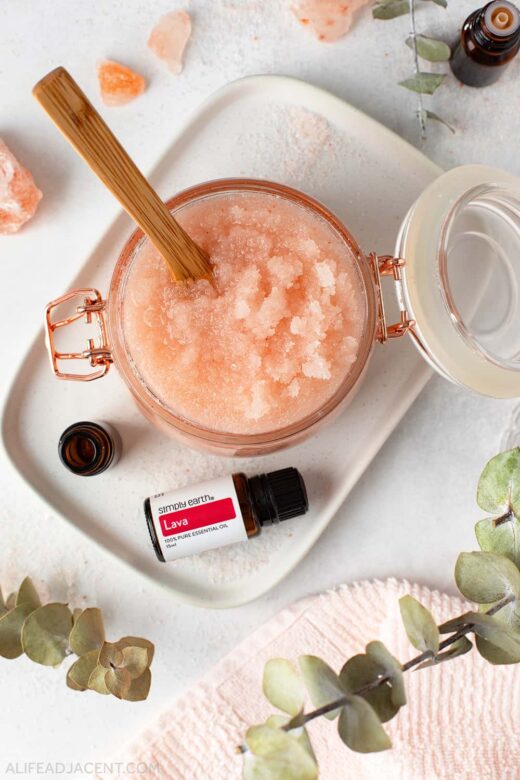
Tropical Escape
50 drops Lava essential oil blend OR
15 drops grapefruit essential oil
15 drops ho wood essential oil
10 drops blood orange essential oil
10 drops sandalwood essential oil
This energizing, citrusy blend of grapefruit, blood orange, ho wood and sandalwood smells like a tropical getaway, creating the perfect scrub to wake up your skin and your senses.
Sore Muscles
30 drops peppermint supreme essential oil
20 drops rosemary essential oil
Peppermint and rosemary oil are an effective duo for a pain relief salt scrub10, promoting blood circulation and relief for tired, sore muscles.
Beach Vacation
50 drops Love essential oil blend OR
20 drops sweet orange essential oil
20 drops amyris essential oil
10 drops ylang-ylang essential oil
This tropical essential oil blend will transport you to a relaxing beach vacation, while ylang-ylang supports feelings of self-love.
Sleep and Relaxation
20 drops lavender essential oil
20 drops ho wood essential oil
10 drops vanilla essential oil (or vanilla blend)
The smell of lavender relaxes the mind and body11, making this an ideal salt scrub recipe to use during your bedtime shower for restful sleep.
Fresh and Clean
20 drops eucalyptus essential oil
20 drops tea tree essential oil
5 drops cedarwood essential oil
5 drops patchouli essential oil
Get sandal ready and rejuvenate your feet with a pink salt scrub blend to smooth dry heels and calluses. This blend also combines naturally antibacterial and deodorant essential oils12, so it’s perfect for a deodorizing foot scrub.
Anti-Cellulite
30 drops grapefruit essential oil
20 drops juniper berry essential oil
Astringent oils like grapefruit and juniper berry are linked to improving the appearance of cellulite13, making them ideal for a firming salt scrub. In particular, grapefruit oil promotes lymph flow and the removal of toxins and excess fluids14, which can help skin appear firmer.
Pink Salt Scrub FAQ
How to package homemade salt scrub
Options for packaging this Himalayan salt scrub include a wide mouth mason jar or a clamp lid jar, such as the glass jar with rose gold clasp pictured in the photos.
Be sure that whatever packaging you use has an airtight lid. If you need more ideas, see this article compiling our favorite skincare containers.
To gift your pink salt scrub, add a gift tag attached with ribbon or cotton string for a homemade touch. See an example of simple handmade gift tags in our rose bath bombs.
How to store a Himalayan salt scrub?
Store your pink salt scrub in a cool, dark place such as a cupboard, drawer or pantry away from direct sunlight and moisture.
How long does pink salt scrub last?
To determine your Himalayan salt scrub shelf life, check the labels of your ingredients. For instance, refer to the expiry date on your carrier oil for the best estimate.
Like all salt, Himalayan salts last indefinitely if stored in a dry, cool location. However, essential oils may oxidize within 2 years or less.
As a general rule, use this pink salt scrub within 6-12 months for best results, and seal the container tightly between uses.
How often should you use a Himalayan salt scrub?
Use a pink salt scrub to exfoliate your skin 1-2 times a week. Those with sensitive skin may want to use it less often, if at all.
Can you use a salt scrub on your face?
No, you shouldn’t use a scrub with salt on facial skin. A Himalayan salt scrub is more suited to areas with thicker skin such as heels, elbows and knees.
Salt is highly abrasive and can cause micro-tears on delicate facial skin. For light facial exfoliation, we recommend our ultra-gentle cranberry face scrub. For dual cleansing and exfoliating, our exfoliating papaya cleansing balm recipe for glowing skin works wonderfully.
Can you add other salts to a Himalayan salt scrub?
You can use another salt such as sea salt to make body scrub, but since this is a pink salt scrub, we’ve stuck to Himalayan salt for this recipe!
Himalayan salt scrub side effects
Are there any side effects to a Himalayan salt scrub? When used in moderation and applied gently, salt scrubs are generally safe, but it’s up to you to determine whether it’s safe for your skin type15.
You should talk to your health care provider before using a salt scrub if you have any inflammatory skin conditions. If you have very sensitive, irritated, or allergy-prone skin, a pink salt scrub may not be right for you.
Do not use a salt scrub on sunburnt, razor-burned or freshly shaved skin, or if you have any open wounds, cuts, or bug bites.
Finally, it’s always a good idea to do a patch test to check for allergies. If you experience any redness or skin irritation, discontinue use.
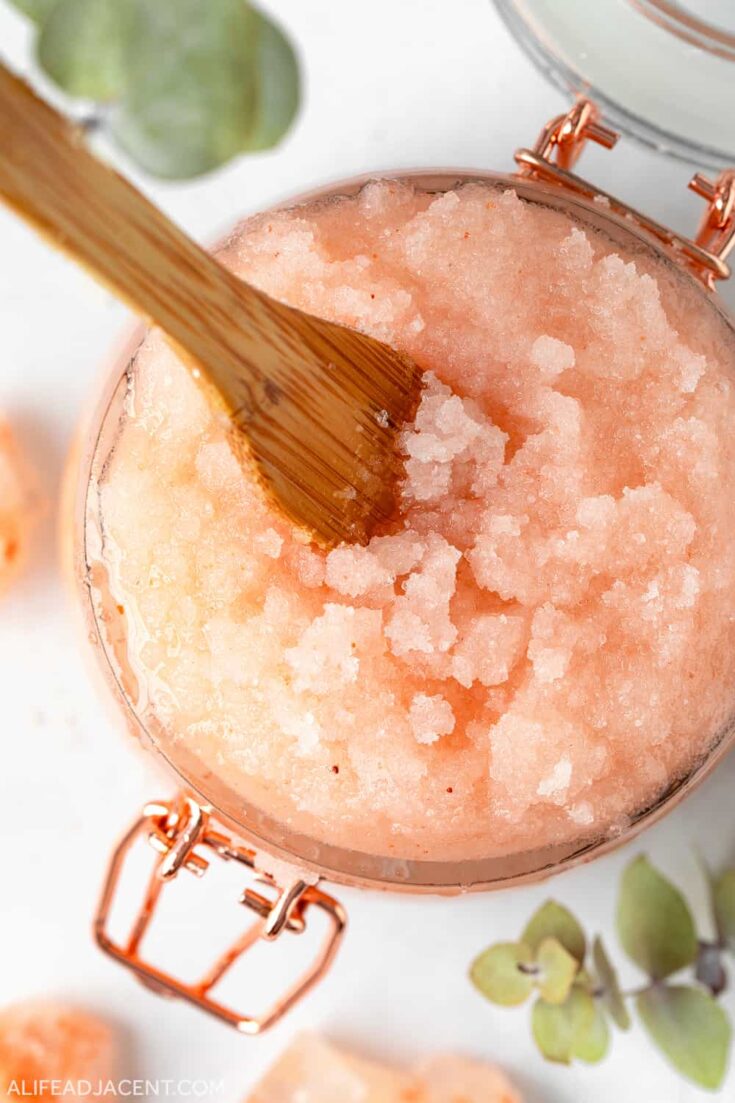
Himalayan Salt Scrub Recipe
This Himalayan salt scrub DIY is both gently exfoliating yet incredibly nourishing for dry skin. Instead of indulging in that expensive salt glow spa treatment, learn how to make a natural pink salt scrub recipe for softer, smoother, more glowing skin at home.
Ingredients
Instructions
- Combine salt + oil. Measure the Himalayan pink salts into a large mixing mixing bowl and pour the MCT oil (or carrier oil of choice) over the salts. Stir the mixture with a wooden spoon until evenly coated.
- Melt shea butter. Using the microwave (or a butter warmer on the stovetop), melt the shea butter. Watch carefully and do not overheat, as this small amount of shea butter will liquefy quickly.
- Add shea butter + emulsifier. Pour the melted shea butter over the pink salt scrub mixture. If adding an emulsifier, add it during this step as well. Mix well to ensure everything is evenly incorporated.
- Add essential oils. Add your favorite essential oil blend and stir the mixture again until evenly combined.
- Package scrub. Transfer the Himalayan salt scrub to an airtight storage container for use, such as a wide mouth mason jar or a clamp lid jar.
Notes
- If your pink salts are coarse, you can use a food processor or coffee grinder to grind the salt crystals into fine granules.
- Do not let water get into the scrub jar, or it may grow mold and harmful bacteria. Transfer your desired amount into a separate container before use.
- For a finer texture, you can also opt to make the salt scrub in a food processor.
- Store your Himalayan salt scrub in a cool, dry place and use within 1 year for best results. MCT oil and fractionated coconut oil have long shelf lives, but essential oils may expire sooner.
- Be sure to use liquid fractionated coconut oil in your body scrub, not melted regular coconut oil.
Recommended Products
As an Amazon Associate and member of other affiliate programs, we earn from qualifying purchases.
More Himalayan salt skincare recipes
We hope you enjoyed this pink salt scrub tutorial. We think it would make for a thoughtful hostess gift, a treat for your best friend or as a wellness and self-care gift for someone special in your life.
For more recipes using Himalayan salts, including body scrubs for glowing skin, you might like:
- Himalayan Salt Bath for Self-Care
- Green Tea Bath Recipe
- Rosemary Sugar Scrub Recipe
- Grapefruit Sugar Scrub
- DIY Coffee Body Scrub
- Sugar Cookie Body Scrub
- Pink Lemonade Bath Soak with Pink Salt
For even more DIY bath and body recipes, follow us on Pinterest, Instagram, YouTube, Facebook, TikTok, and Twitter.
📌 Pin it for later

- Sarker, Apurbo, et al. “Halite; the Rock Salt: Enormous Health Benefits.” World Journal of Pharmaceutical Research, wjpr.net/abstract_file/6177. Accessed 25 Nov. 2023. doi:10.20959/wjpr201612-7482
- Herrera, Luis. “The Pure Difference: Himalayan Salt vs. Sea Salt.” LinkedIn, 19 May 2023, www.linkedin.com/pulse/pure-difference-himalayan-salt-vs-sea-luis-herrera/. Accessed 25 Nov. 2023.
- Fayet-Moore, Flavia et al. “An Analysis of the Mineral Composition of Pink Salt Available in Australia.” Foods (Basel, Switzerland) vol. 9,10 1490. 19 Oct. 2020, doi:10.3390/foods9101490
- Rodan, Katie et al. “Skincare Bootcamp: The Evolving Role of Skincare.” Plastic and reconstructive surgery. Global open vol. 4,12 Suppl Anatomy and Safety in Cosmetic Medicine: Cosmetic Bootcamp e1152. 14 Dec. 2016, doi:10.1097/GOX.0000000000001152
- Wijnker, J J et al. “Antimicrobial properties of salt (NaCl) used for the preservation of natural casings.” Food microbiology vol. 23,7 (2006): 657-62. doi:10.1016/j.fm.2005.11.004
- Preston, Kahla. “Myth or Fact: Is Salt Water Good for Your Skin?” Mamamia, 22 Feb. 2016, www.mamamia.com.au/is-salt-water-good-for-your-skin/.
- Timesofindia.com. “Purification and Cleansing Using Salt.” The Times of India, 15 Oct. 2023, timesofindia.indiatimes.com/life-style/soul-search/the-spiritual-and-healing-benefits-of-salt/photostory/104395686.cms?picid=104395723. Accessed 25 Nov. 2023.
- “Caprylic/Capric Triglyceride.” Caprylic/Capric Triglyceride (Emollient): Cosmetic Ingredient INCI, cosmetics.specialchem.com/inci-ingredients/caprylic-capric-triglyceride. Accessed 25 Nov. 2023.
- Bowe, Whitney P, and Alan C Logan. “Clinical implications of lipid peroxidation in acne vulgaris: old wine in new bottles.” Lipids in health and disease vol. 9 141. 9 Dec. 2010, doi:10.1186/1476-511X-9-141
- Mohammadifar, Mojgan et al. “Anti-osteoarthritis potential of peppermint and rosemary essential oils in a nanoemulsion form: behavioral, biochemical, and histopathological evidence.” BMC complementary medicine and therapies vol. 21,1 57. 9 Feb. 2021, doi:10.1186/s12906-021-03236-y
- Koulivand, Peir Hossein et al. “Lavender and the nervous system.” Evidence-based complementary and alternative medicine : eCAM vol. 2013 (2013): 681304. doi:10.1155/2013/681304
- Orchard, Ané, and Sandy van Vuuren. “Commercial Essential Oils as Potential Antimicrobials to Treat Skin Diseases.” Evidence-based complementary and alternative medicine : eCAM vol. 2017 (2017): 4517971. doi:10.1155/2017/4517971
- Orchard, Ané, and Sandy van Vuuren. “Commercial Essential Oils as Potential Antimicrobials to Treat Skin Diseases.” Evidence-based complementary and alternative medicine : eCAM vol. 2017 (2017): 4517971. doi:10.1155/2017/4517971
- Dosoky, Noura S, and William N Setzer. “Biological Activities and Safety of Citrus spp. Essential Oils.” International journal of molecular sciences vol. 19,7 1966. 5 Jul. 2018, doi:10.3390/ijms19071966
- “How to Safely Exfoliate at Home.” American Academy of Dermatology, www.aad.org/public/everyday-care/skin-care-secrets/routine/safely-exfoliate-at-home. Accessed 25 Nov. 2023.




